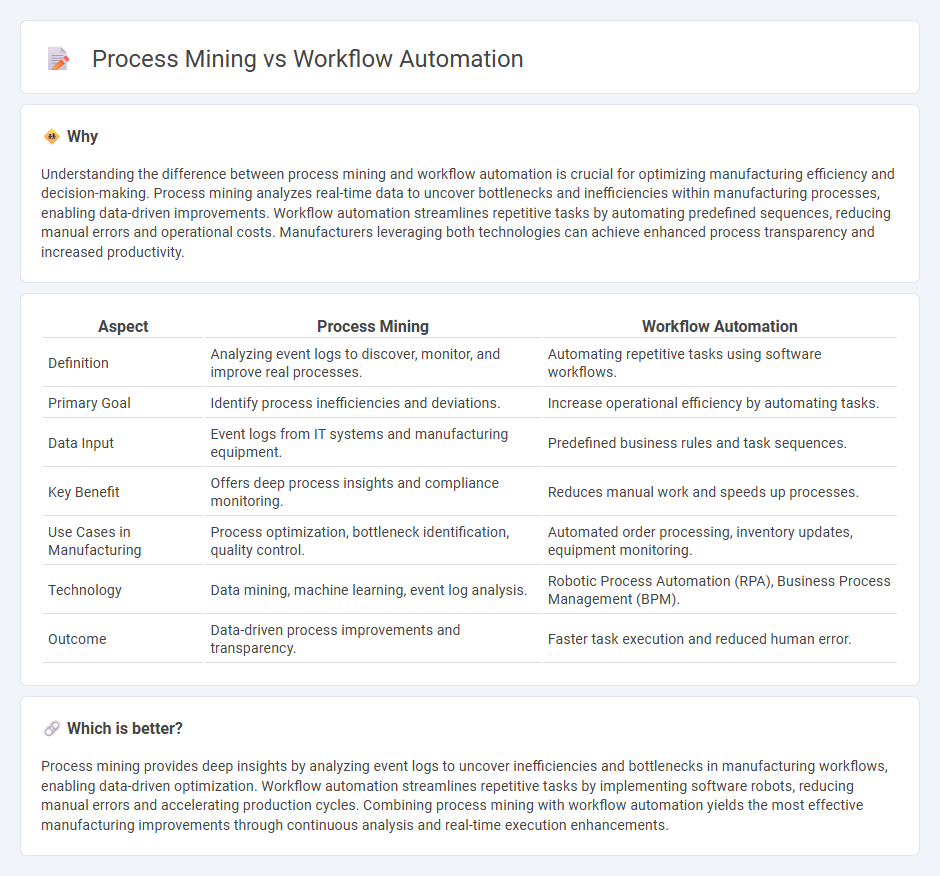
Process mining leverages data from event logs to analyze and visualize the actual manufacturing workflows, identifying inefficiencies and bottlenecks for improvement. Workflow automation streamlines repetitive manufacturing tasks by implementing rule-based systems and robotic process automation to increase efficiency and reduce human error. Explore how integrating process mining with workflow automation can transform manufacturing operations for enhanced productivity.
Why it is important
Understanding the difference between process mining and workflow automation is crucial for optimizing manufacturing efficiency and decision-making. Process mining analyzes real-time data to uncover bottlenecks and inefficiencies within manufacturing processes, enabling data-driven improvements. Workflow automation streamlines repetitive tasks by automating predefined sequences, reducing manual errors and operational costs. Manufacturers leveraging both technologies can achieve enhanced process transparency and increased productivity.
Comparison Table
| Aspect | Process Mining | Workflow Automation |
|---|---|---|
| Definition | Analyzing event logs to discover, monitor, and improve real processes. | Automating repetitive tasks using software workflows. |
| Primary Goal | Identify process inefficiencies and deviations. | Increase operational efficiency by automating tasks. |
| Data Input | Event logs from IT systems and manufacturing equipment. | Predefined business rules and task sequences. |
| Key Benefit | Offers deep process insights and compliance monitoring. | Reduces manual work and speeds up processes. |
| Use Cases in Manufacturing | Process optimization, bottleneck identification, quality control. | Automated order processing, inventory updates, equipment monitoring. |
| Technology | Data mining, machine learning, event log analysis. | Robotic Process Automation (RPA), Business Process Management (BPM). |
| Outcome | Data-driven process improvements and transparency. | Faster task execution and reduced human error. |
Which is better?
Process mining provides deep insights by analyzing event logs to uncover inefficiencies and bottlenecks in manufacturing workflows, enabling data-driven optimization. Workflow automation streamlines repetitive tasks by implementing software robots, reducing manual errors and accelerating production cycles. Combining process mining with workflow automation yields the most effective manufacturing improvements through continuous analysis and real-time execution enhancements.
Connection
Process mining leverages data from manufacturing systems to visualize and analyze actual workflows, identifying inefficiencies and bottlenecks. Workflow automation uses these insights to streamline operations by automating repetitive tasks, reducing manual errors, and accelerating production cycles. Integrating process mining with workflow automation enhances manufacturing efficiency, improves resource allocation, and supports continuous process optimization.
Key Terms
Robotic Process Automation (RPA)
Robotic Process Automation (RPA) drives workflow automation by using software bots to execute repetitive tasks efficiently and reduce human error. Process mining complements RPA by analyzing event logs to discover, monitor, and improve workflows, enhancing automation outcomes. Explore how integrating RPA with process mining optimizes operational performance and accelerates digital transformation.
Event Logs
Event logs are critical in both workflow automation and process mining, serving distinct purposes; in workflow automation, they track real-time task execution for system efficiency and deviation detection, while in process mining, they provide comprehensive data for analyzing and visualizing process behavior. Workflow automation uses event logs to trigger automated tasks based on predefined rules, enhancing operational speed and accuracy. Explore how leveraging event logs can optimize your business processes and improve decision-making.
Bottleneck Detection
Workflow automation streamlines repetitive tasks by using software to execute predefined sequences, enhancing efficiency and reducing human error. Process mining involves analyzing event logs from IT systems to visualize workflows, identify bottlenecks, and uncover inefficiencies that limit throughput. Discover how combining workflow automation with process mining can optimize bottleneck detection and boost operational performance.
Source and External Links
What is Workflow Automation? [+ Benefits & How to Start] - Atlassian - Workflow automation uses software to route tasks and information between people and systems based on predefined rules, saving time and reducing errors by automating repetitive steps and triggers.
Workflow Automation: Definition, Benefits & How to Get Started - Workflow automation is the use of technology to execute a predefined sequence of tasks with minimal manual intervention, triggered by specific events and guided by rules that dictate actions and outcomes.
What is Workflow Automation and Why is it Important? - TechTarget - Workflow automation enables tasks, documents, and information to flow independently across business activities, improving efficiency, reducing errors, and allowing processes to run without constant human oversight.
 dowidth.com
dowidth.com